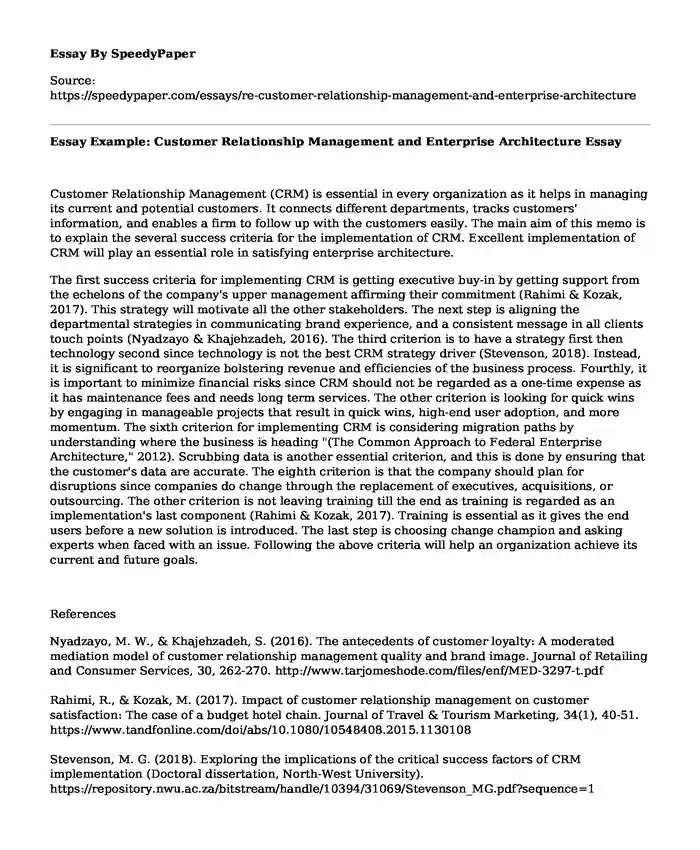Customer Relationship Management (CRM) is essential in every organization as it helps in managing its current and potential customers. It connects different departments, tracks customers' information, and enables a firm to follow up with the customers easily. The main aim of this memo is to explain the several success criteria for the implementation of CRM. Excellent implementation of CRM will play an essential role in satisfying enterprise architecture.
The first success criteria for implementing CRM is getting executive buy-in by getting support from the echelons of the company's upper management affirming their commitment (Rahimi & Kozak, 2017). This strategy will motivate all the other stakeholders. The next step is aligning the departmental strategies in communicating brand experience, and a consistent message in all clients touch points (Nyadzayo & Khajehzadeh, 2016). The third criterion is to have a strategy first then technology second since technology is not the best CRM strategy driver (Stevenson, 2018). Instead, it is significant to reorganize bolstering revenue and efficiencies of the business process. Fourthly, it is important to minimize financial risks since CRM should not be regarded as a one-time expense as it has maintenance fees and needs long term services. The other criterion is looking for quick wins by engaging in manageable projects that result in quick wins, high-end user adoption, and more momentum. The sixth criterion for implementing CRM is considering migration paths by understanding where the business is heading "(The Common Approach to Federal Enterprise Architecture," 2012). Scrubbing data is another essential criterion, and this is done by ensuring that the customer's data are accurate. The eighth criterion is that the company should plan for disruptions since companies do change through the replacement of executives, acquisitions, or outsourcing. The other criterion is not leaving training till the end as training is regarded as an implementation's last component (Rahimi & Kozak, 2017). Training is essential as it gives the end users before a new solution is introduced. The last step is choosing change champion and asking experts when faced with an issue. Following the above criteria will help an organization achieve its current and future goals.
References
Nyadzayo, M. W., & Khajehzadeh, S. (2016). The antecedents of customer loyalty: A moderated mediation model of customer relationship management quality and brand image. Journal of Retailing and Consumer Services, 30, 262-270. http://www.tarjomeshode.com/files/enf/MED-3297-t.pdf
Rahimi, R., & Kozak, M. (2017). Impact of customer relationship management on customer satisfaction: The case of a budget hotel chain. Journal of Travel & Tourism Marketing, 34(1), 40-51. https://www.tandfonline.com/doi/abs/10.1080/10548408.2015.1130108
Stevenson, M. G. (2018). Exploring the implications of the critical success factors of CRM implementation (Doctoral dissertation, North-West University). https://repository.nwu.ac.za/bitstream/handle/10394/31069/Stevenson_MG.pdf?sequence=1
The Common Approach to Federal Enterprise Architecture. (2012). https://www.immagic.com/eLibrary/ARCHIVES/GENERAL/WHITEHSE/W120502C.pdf
Cite this page
Essay Example: Customer Relationship Management and Enterprise Architecture. (2022, Feb 24). Retrieved from https://speedypaper.com/essays/re-customer-relationship-management-and-enterprise-architecture
Request Removal
If you are the original author of this essay and no longer wish to have it published on the SpeedyPaper website, please click below to request its removal:
- Free Essay on the Misogynistic Portrayal of Women in Oscar Wilde's Play, The Importance of Being Earnest
- Free Paper with Human Resource Management Case Studies
- Free Essay Sample on Women's Inequality and Feminism
- Essay Example: How Progressive America Was During the Progressive Era
- Analysis of 1951 Short Film, "Duck and Cover". Free Essay
- Free Essay. Technology and Second Language Teaching and Learning
- Paper Example on Value Marketing and 4Ps Marketing Strategies
Popular categories





